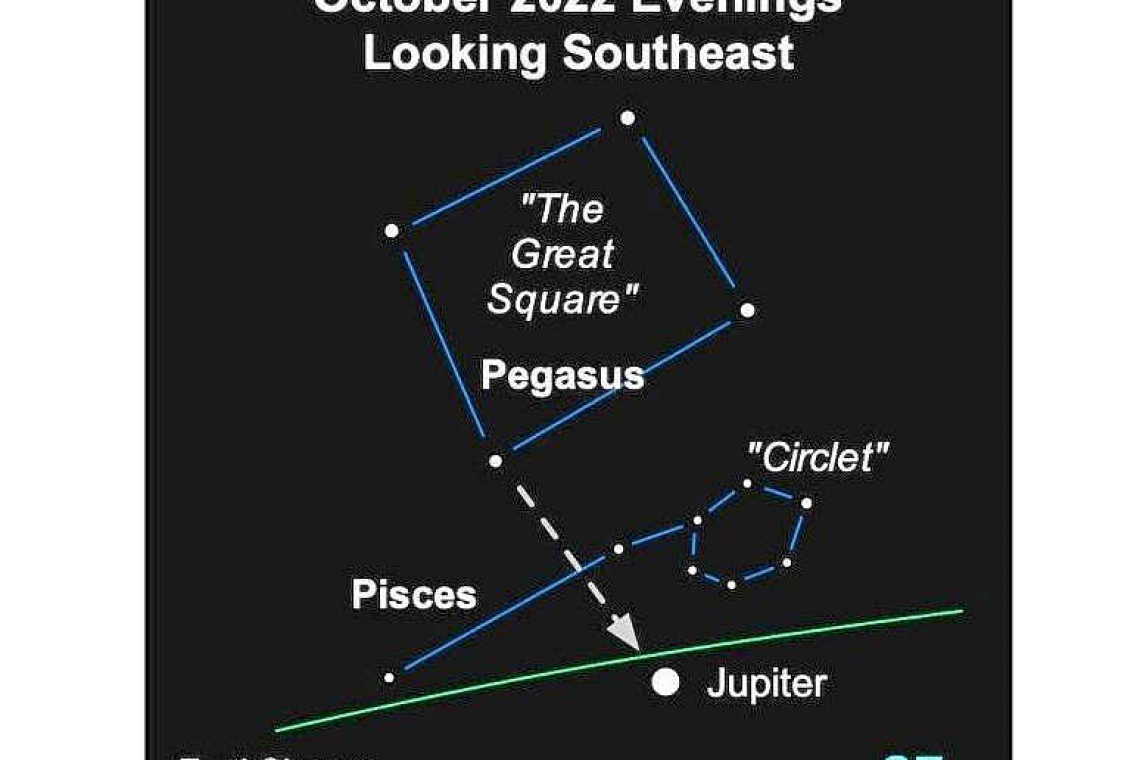~ St. Maarten’s Backyard Astronomy for October 7-9 ~
Sun rises at 6:05am
Sun sets at 5:55pm
Lunar phase: full moon
Moon sets at 4:45pm, Saturday
Moon rises at 5:26pm, Saturday
October’s full moon is upon us – the hunter’s moon. And alongside the full moon, the solar system’s largest planet is currently in the evening sky. We are of course speaking of Jupiter, which just had its closest opposition to earth in 70 years. That happened on September 26, and now, less than two weeks later, it is still shining just as brightly. As discussed last week, Jupiter has been located among the stars of Pisces, not far from the Circlet – a pretty but faint group of six stars that make up part of Pisces.
Look for the almost-full moon in Aquarius today, Friday, October 7. Then on Saturday, October 8, the moon will be even brighter, with more of its face beaming down on us. The moon on Saturday night will appear full to our eyes (though Sunday is the official full moon). Look for it just below Jupiter, between Pisces and Cetus the Whale. By Sunday, October 9, the truly full Hunter’s Moon will be in Pisces – seems like we should call it the fisherman’s moon, right?
The October full moon is kind of special because, at this time of year (near the Autumnal Equinox), the angle of the moonrise is shallower against the eastern horizon, thus allowing more evenings with a seemingly full-shaped moon in the east after sunset.
The orange colour of a rising full moon is the result of the thick atmosphere the moonlight must pass when it sits low on the horizon, as opposed to when you gaze up and overhead. The atmosphere scatters blue light, which is why the sky looks blue, but lets red light pass through to reach your admiring eyes. So, a full moon near the horizon generally takes on a yellow, orange or reddish coloration.
Another feature of the hunter’s full moon is its apparent size. If you watch it rise, it may appear quite huge, but that is an illusion. The landscape and buildings in your peripheral vision are available for visual comparison, making it seem much larger than when it is up high overhead. Test the illusion by covering the moon with your thumb held out at arm’s length. Whether at the horizon or overhead, the moon is the same size. Even so, I think you and I can agree the effect is stunning, often breath-taking, and reminds us that nature is awesome.
Thank you for keeping up with the Night Sky articles, backyard astronomy designed for St. Maarten sky viewing. FYI: If you are out later on in the week, note that each star rises about four minutes earlier each day than written here, and the moon rises 50 minutes later. Night Sky is researched and compiled by Lisa Davis-Burnett. Earthsky.org is a key resource for information and images. Questions or comments? Email This email address is being protected from spambots. You need JavaScript enabled to view it.







